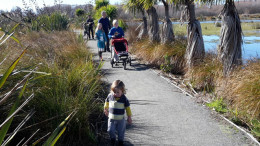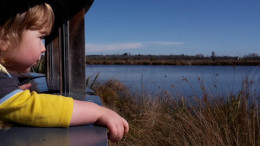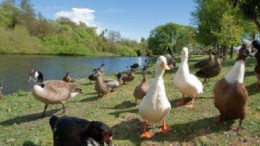Travis Wetland covers 116 hectares of previously farmed and drained natural wetland. Purchased by the Christchurch City Council in 1996, it is now managed as a Nature Heritage Park.
Access
Travis Wetland is located at 280 Beach Rd, Burwood.
The main car park and access point for Travis Wetland is at the end of Beach Road, where it intersects with Mairehau and Frosts Road. There are also multiple pedestrian access ways off Mairehau Road and from Clarevale Reserve.
Opening hours
- Gate open 8am to 8pm year-round.
- Ring Christchurch City Council on 0800 800 169 or 941 8999 to release locked in vehicles at owner's expense.
Dogs
To protect locally rare birdlife, dogs are prohibited from being anywhere in Travis Wetland.
Bikes, scooter and skateboards
Bikes, scooters (electric or manual) and skateboards are prohibited from Travis Wetland.
Facilities
There is an information kiosk showcasing the story of Travis Wetland. The nearby education centre provides a laboratory and educational facility for visiting school groups.
Travis Wetland offers easy walkways that are wheelchair and pushchair accessible in dry weather conditions.
There are public toilets near the main car park.
Travis Wetland has a great walking track with wide gravel pathways and boardwalks. The entire walk is accessible for both wheelchairs and strollers.
The viewing areas at the Bird Hide and Stout Tower offer opportunities to see many bird species and plant communities.
Education programmes are available for schools through Learning Through Action to promote ecological values.
Families can also earn a Kiwi Guardian (external link)medal here.
Find out more on the Department of Conservation (external link)website.
The Travis Wetland Trust(external link) is very active in Travis Wetland and often organise working bees and events.
Join one of the many community plantings that occur throughout the year.
This field guide(external link) explains how 15 numbered stopping sites fit into the restoration efforts.
It lists what to look out for with identification clues for some birds, plants or insects you might see.
In June 1976, an announcement was made in a local newspaper that set off one of the biggest conservation and environmental fights Christchurch had seen.
The announcement said that plans had been drawn up for a multi-million dollar housing development in northeast Christchurch to provide homes and community facilities for 5000 people.
A feature of the housing development was to be a 16-hectare lake, created when sand was taken from the area to provide fill for the building sections. From that date on battle lines were drawn.
The fight went on until May 1996 when the Christchurch City Council announced its decision to buy the remaining 60 hectares of Travis Wetland “after prolonged and often bitter negotiations with the owner, Travis Country Estates Ltd.”
The article in the Press said: “When added to the 55.92 ha area already owned by the council, the area would be developed as a nature heritage park.”
This resource details the 20 year struggle to preserve Travis Wetland for the city of Christchurch. [PDF, 510 KB]
Natural history
This resource looks at environmental, development and planning issues surrounding Travis Wetland – why the wetland is so highly valued by the people of Christchurch, the pressures that are coming to bear on this environment and how the use of the wetland is managed.
Christchurch is built on a mix of old gravel beds from the Waimakariri River, sand dunes and wetland areas. Over the years these wetlands have been drained and filled to make the land suitable for housing and farming.
This development means that today only two per cent of the original wetlands in the Christchurch area remain. Travis Wetland is the last large freshwater wetland in Christchurch.
As such this area is very important as a habitat for native wetland plants and birds and has considerable educational value by showing residents and visitors to Christchurch what the city used to be like.
Plants
Travis Wetland is an important site for the local and regional conservation of wetland plants.
Even though highly modified by human occupation, as a whole it still retains an important representation of Christchurch’s former range of indigenous species.
Nearly 80% of pre-European native wetland plant species are present in the wetland, including several species now rare on the Canterbury Plains.
These include the only substantial stand of manuka, a species of spider orchid and a native sundew which are regionally vulnerable.
Birds and animals
There are 53 species of birds (30 native species) including 77% of the native freshwater wetland birds of lowland Canterbury have been recorded in the wetland. It is the most important freshwater wetland for birds in Christchurch and supports around half of Christchurch’s total pukeko population.
The swamp contains Canterbury’s largest winter concentration of pukeko, peaking at over 700 birds. Due largely to the destruction of other local habitats, Travis Wetland is the only location in the region where pukeko numbers are increasing.
Conservation of the habitat for this bird, therefore, is a matter of local and regional importance. The park also provides occasional habitat for rare species such as the white heron. Two globally endangered species that have been recorded in the last five years are the Australian bittern and black stilt.
The estimated diversity of 700 to 900 invertebrate (insect) species is moderately high, compared with other lowlands, largely non-wooded sites. It has been estimated that 7090 of these insects are not well known to scientists.
Also, 83% of the known invertebrates sampled are found only in New Zealand. It is likely that there are over 100 other invertebrate species in the wetland area that were not captured during the invertebrate surveys.
An indigenous skink and the native short-finned eel have been observed at the wetland, with possible sightings of the Canterbury mudfish.
Soil and landform
The site as a whole contains very good examples of soil types found in Christchurch. Due to farming and urban development, most soil in Christchurch has been changed so Travis Wetland is useful for scientists to study what Christchurch soils used to be like.
Because the soil is in its natural condition it means that a wide range of native plants can be grown in different parts of the wetland. For these reasons, the site has been listed on the New Zealand Geopreservation Inventory as a soil site of national importance.
Education and research
Travis Wetland has a scientific benefit for the city’s universities and research institutions as a research site. Its size provides a large enough area for studies to be undertaken on a proper scientific basis with intensive or random sampling.
The large area of the wetland also allows undisturbed areas to be available for scientific research, hence avoiding conflicts between the different users and minimising disturbance to the natural values.
The wetland’s location within an intensively developed urban area means that it is easily accessible and is visited by students from primary school to university level. Community trust funding has provided for an on-site education centre with lab and classroom facilities and a visitor information centre.
Recreation and open space corridors
Travis Wetland is an important component of the city’s open space network. When developed as a park it will provide an alternative type of recreation experience for people and communities to meet their social and recreational needs.
It is strategically placed on the eastern green corridor, linking wildlife habitats and recreational areas stretching from the estuary north to Brooklands Lagoon.
Ngai Tahu
Travis Wetland is a mahinga kai (food gathering) site that Ngai Tahu requested to be reserved for them when the land was sold to the European settlers.
Adjacent to this site, on the land now occupied by QEII Park, was the residential area for the families of Ngai Tahu who harvested these wetlands.
Representatives of Ngai Tahu are involved in discussions concerning the future management of the wetland so that its cultural values can be protected and improved.
Urban development
The biggest planning issue that has faced Travis Wetland over the years is the balance between the private landowners wanting to develop the site for residential subdivision and conservationists wanting to protect the wetland for its ecological and social values.
This issue was largely resolved in 1996 when the Christchurch City Council purchased most of the wetland for conservation while allowing limited subdivision in the south-west corner.
The Council overcame this problem by offering to buy the land for the same price that the developers would have received if they had sold the land for housing.
Weeds
Another major resource management issue is protecting the natural values of the wetland from exotic weeds and predators.
Weeds such as gorse, broom and blackberry must be controlled or they will grow faster than native species and gradually replace the native species which provide habitat for native insects and birds.
While the willow trees may look attractive, they can also cause problems. Grey willows spread particularly fast and unless controlled will gradually cover the wetland, replacing native plants and habitat for native birds. This issue has been addressed and resolved by a combination of methods.
Community groups such as the Travis Wetland Trust and workers organised by the Council’s Parks Unit have working days to remove willows and weeds.
The Council also grazes the land with cattle so that the cattle eat the exotic grasses and weeds before they become a problem. As pukeko like open pasture, rather than dense vegetation like willows, to feed on, grazing the land helps to maintain the pukeko habitat.
Predators
To help increase native bird numbers, predators must be controlled. Animals that eat birds, eggs and chicks include stoats, ferrets, weasels (all known as mustelids), rats, cats and dogs. Even pet cats and dogs can be a problem.
The risk of pet cats entering the wetland is a major concern, with cat numbers potentially increasing due to the new houses built next to the wetland. To help overcome this problem the developer and the Council reshaped the wetland waterways making a moat between the houses and the wetland so that cats and dogs are less likely to enter.
To provide birds extra protection, the Council created shallow lakes and ponds in the middle of the wetland to form islands. Birds are able to nest on these islands without threat from predators.
In the future, it may be necessary to make traps to catch mustelids and rats. A predator monitoring programme is being undertaken by Landcare.
Habitat enhancement
As the wetland is now publicly owned it is hoped that the habitat for birds will continue to be enhanced by planting more native species and by creating new waterways and ponding areas. Native species planting is carried out by the Council, schools, community groups and residential developers.
Recreation
There is great public demand to visit the wetland. There is also the potential for conflict between recreational access and the need to protect plants and birds.
As the wetland is improved it will attract more birds. If large numbers of people visit, the risk of damage to the very environment they have come to look at could be high.
It is hoped to resolve this issue by carefully locating tracks so that people avoid trampling rare plant species and screening tracks and wildlife viewing areas with plants will reduce the impact of birds being frightened.
Tracks could also run primarily around the edge of the wetland to allow a large undisturbed area in the middle for birds to rest and feed in.
Management of Travis Wetlands
Management of the use of Travis Wetland is primarily through the Reserves Act. Half of the Reserve is gazetted as a scenic reserve.
The Resource Management Act (1991) charges district/city councils with managing the use, development and protection of land, essentially carried out through district/city plans. These plans state the way in which land can be managed.
Management of the use of the land can be carried out in a number of ways, including purchasing of land for reserves, provision of works and services and provision of information.
It is all about balance and the challenge set down by the Act is to sustainably manage our natural and physical resources.
Other organisations with various types of jurisdiction over Travis Wetland including the Department of Conservation(external link), Ngai Tahu(external link) and Ngai Tahuriri and Environment Canterbury(external link).
At a global environmental summit held in Rio de Janeiro in 1992, New Zealand was a signatory to a document now known as Agenda 21.
This document focuses on a number of issues, including the need to conserve global biodiversity, that is, a representative and sustainable example of plant and animal life.
New Zealand has a moral obligation to maintain and enhance the plants and animals unique to this country as our contribution to global conservation. New Zealand has ratified the biodiversity convention resulting from this summit.
Conservation of Travis Wetland is an example of how the purpose of both the Resource Management Act 1991 and Agenda 21 can be expressed at a local level.
Currently, some 1000 indigenous animal, plant and fungi species are under threat in New Zealand.
The Department of Conservation and the Ministry for the Environment have developed a biodiversity strategy that discusses ways to preserve the many different and unique species we have in New Zealand.
Some of the strategy’s goals include improving the condition of protected land areas and the prospects for threatened species, managing the marine environment so that biodiversity is maintained and sustaining biodiversity on private land and in freshwater environments.
In order to contribute to the national biodiversity strategy at a local level, the Christchurch City Council has developed a Biodiversity Strategy for Christchurch.
- Travis Wetland Landscape Development Plan – Christchurch City Council Parks Unit
- Travis wetland Compilation of technical reports as presented to the Environmental Committee - 13 March 1996
- Indigenous Ecosystems Booklet series
Relevant information such as committee reports and newspaper articles can be sourced from the Aotearoa New Zealand Centre at the Central City Library(external link).
Librarians at the Central City Library are available to assist with research projects, as are staff at the Christchurch Environment Centre.
Residents’ Associations, another useful source, can be found on the Christchurch City Libraries’ community information Christchurch – CINCH database(external link).






